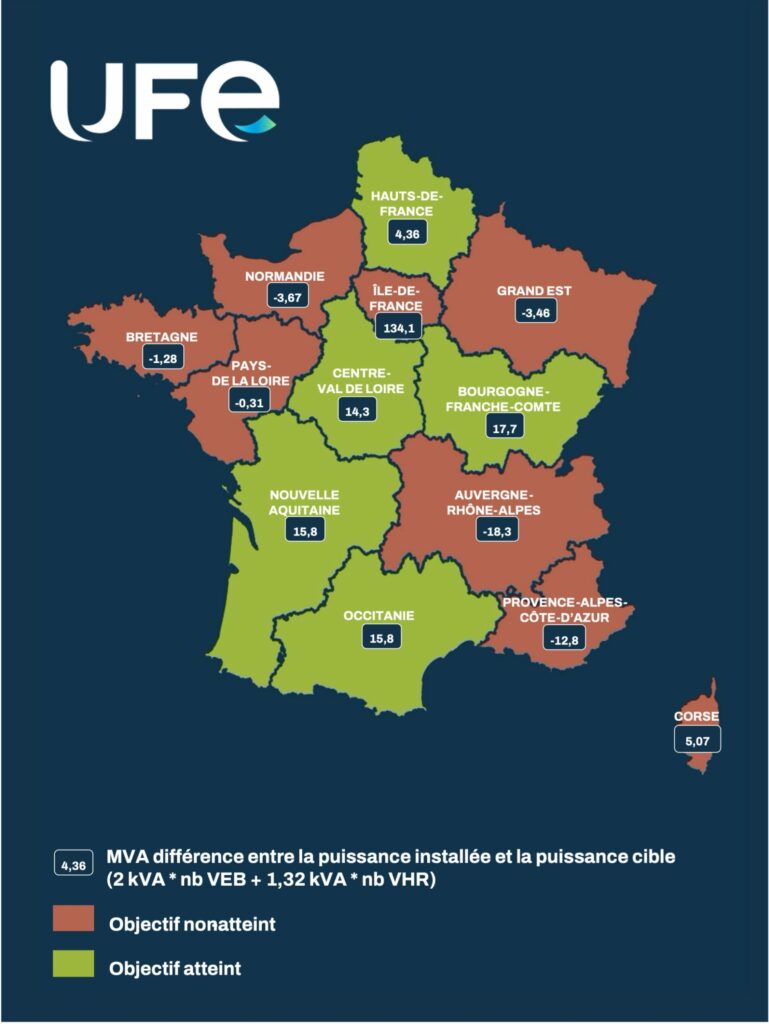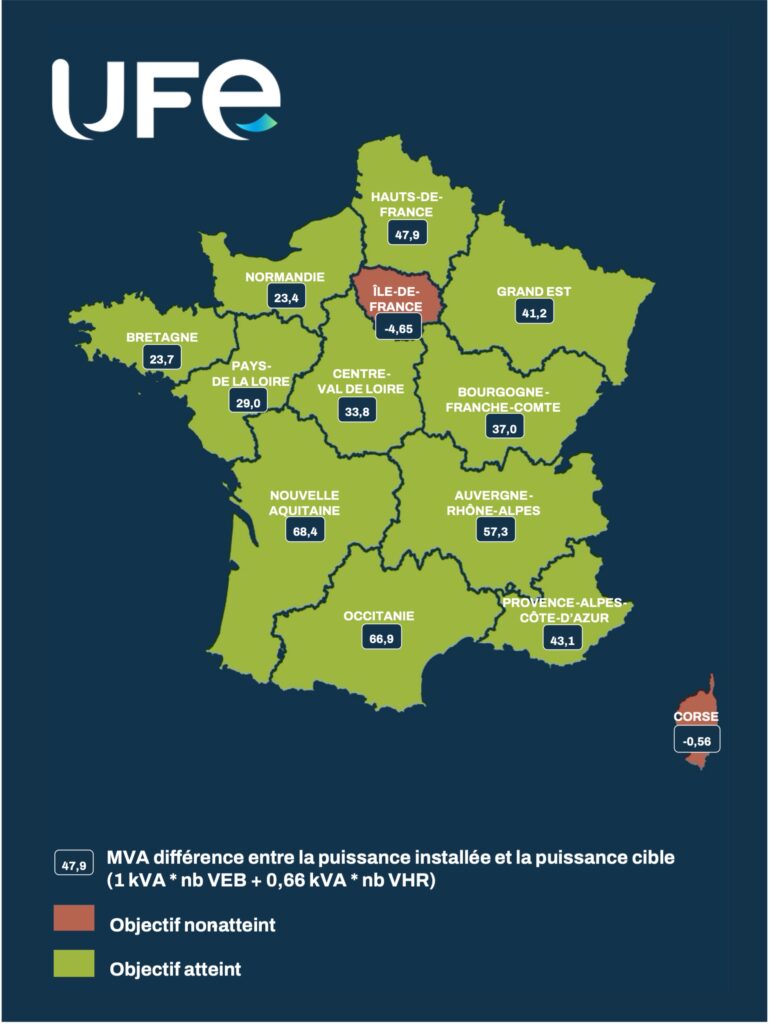22 November 2021
UFE’s reply to the consultation of the European Commission on the proposal of a new Regulation on the Alternative Fuels Infrastructure
UFE, the association representing the French Electricity industry, supports the proposal made by the European Commission for a new Regulation on the Alternative Fuels Infrastructure: it sends positive signals regarding the electrification of transport, a necessity to decarbonise this sector. Key provisions, that UFE and the electromobility sector have repeatedly called for, are integrated in the proposal, such as minimum mandatory targets. These targets provide further incentives for Member States to accelerate the deployment of charging stations in their territory in a harmonised and consistent manner. UFE also welcomes the new provisions on price transparency (art. 5) ensuring that it is as easy to recharge an EV at a public charging station as it is currently to fill an ICE vehicle with fuel.
UFE believes that some improvements should however be made to ensure the proposal is fit for the objective of 1 million public chargers deployed by 2024.
Recommendations on the definitions of the regulation (Art. 2)
UFE supports the new definition of ‘alternative fuels’ (art. 2.5) which mainly includes sustainable fuels, essential to decarbonise the transport sector, and which gives a limited and temporary role to the ‘alternative fossil fuels’ for a transitional phase.
However, UFE identifies a lack of consistency between the definitions set in the AFIR and those set in the revision of the Renewable Energy Directive, in particular regarding the definitions of ‘bidirectional charging’ (art. 2.9), ‘recharging point’ (art. 2.42) and ‘smart charging’ (art. 2.59). Therefore, these definitions need to be harmonised in both texts and subsequently in the upcoming revision of the Energy Performance of Buildings Directive (EPBD).
- UFE calls for the possibility to consider smart meters as one of the solutions allowing smart charging (definition in art. 2.14l). The installation of smart meters, among other solutions, plays a role in grid management optimisation and flexibility services promotion.
- The definition of ‘smart charging’ (art.2.59) should be harmonised, in all legislative texts dealing with smart charging (REDIII, EPBD) and amended as follow: “recharging operation launched, stopped or in which the power delivered to the battery, thanks to a variation of its intensity, is adjusted in real-time or in a scheduled manner, possibly via the use of smart meters or other electronic devices based on information received through electronic communication;”.
Recommendations on the level of ambition of the targets for road transport (Art. 3, and 4)
UFE is in favour of the introduction of minimum mandatory targets in the AFIR. But the level of ambition set by the European Commission does not seem sufficient to achieve the objectives of the EU, in particular on short and medium terms for light-duty vehicles. The level of ambition for charging infrastructure is not in line with the proposal to phase-out of internal combustion engines’ sale by 2035 (as proposed in the revision of the CO2 standards Regulation for cars and vans). A lack of ambition could jeopardise the dynamic of charging stations roll out but also that of the demand for EV.
With regard to the fleet-based target, the European Commission aims for a ratio of 12/1 calculated with an average power per load point of approx. 11kW. But in France, the average power output of a charging station is 23 kW. Therefore, when applying this figure to France, taking into account the current power output of the public charging stations deployed, there would already be twice as much power available as required in the AFIR. According to UFE’s projections, in France, only two regions (i.e. Ile-de-France and Corsica) do not currently fulfil the level of capacity-based targets required without however lagging far behind. Furthermore, UFE believes that there is a bias in the Commission’s analysis because it proposes a reasoning in terms of kW used (with a consumption evenly distributed during the year) which does not allow to reply to peak demand. Indeed, UFE would like to underline that the deployment of charging infrastructure should follow a logic of coverage of recharging needs at peak times. By contrast, the methodology proposed in the AFIR seeks an average coverage of the recharging needs when it should consider the actual power delivered by the recharging stations.
The power ratios of 1kW per battery-electric vehicle (BEV) and 0.66kW per plug-in hybrid vehicle (PHEV) would currently be reached by 26 Member States out of 27. This illustrates the lack of ambition.
- We therefore call for an increased target: up to 2 kW/BEV and 1kW/PHEV in order to maintain an ambitious deployment of charging infrastructure. It is particularly essential to do so on the short term, at least until 2030, which is considered as a milestone for the decarbonation of light-duty vehicle market.
- In order to adopt an approach, in definition 37 of art. 2, based on the service provided to consumers, it is essential to take into account the actual power delivered by a charging station and not the maximum power output.
- The distance-based target of 60km between each charging stations along the TEN-T network should be maintained in the upcoming negotiations and this distance should not be increased.
In art. 4, UFE supports the introduction of targets for the deployment of public charging infrastructure for heavy-duty vehicles (and the rationale explained in Recitals 13 and 16) while believing that the calendar might be too ambitious in view of the current state of development of the heavy-duty vehicle (HDV) market.
- UFE recommends aligning the timeline of the AFIR targets for HDVs with the one set in the upcoming Regulation on the CO2 standards for trucks.
Recommendations on hydrogen refuelling stations for road transport (Art. 6)
UFE strongly believes that hydrogen should be used in the heavy transport segment where it is more cost-efficient and where direct electrification is not feasible.
- UFE calls for the scope of art. 6 to be limited to heavy-duty vehicles.
Recommendations on the payment methods (Art. 5.2)
UFE agrees that measures are needed to facilitate the experience of EV consumers, however some changes are needed in the Commission’s proposal in art. 5.2. UFE is particularly concerned about the differentiation made in terms of payment methods between the charging stations according to their power output. We disagree with the Commission’s approach: charging stations with a power output equal to or greater than 50kW should be able to opt for devices using an internet connection (such as QR code) just like those below 50kW.
Indeed, while it is key to ensure that EV users will be able to pay in an easy manner when recharging their vehicles across Europe, it should be noted that payment methods evolve quickly. Therefore, assuming a payment option without leaving room for potential technological developments could lead to the necessity to revise the regulation shortly.
- UFE asks for adding “devices using an Internet connection with which, for instance, a Quick Response code can be specifically generated and used for the payment transaction”, as a subpoint (iii), in point (b) of art. 5.2.
Furthermore, UFE is strongly concerned over the retroactive effect of the provision requiring operators of recharging points to accept electronic payments through terminals and devices used for payment services. Indeed, applying the obligation to existing charging points will bring high and disproportioned compliance cost and might lead, in some cases, to the full replacement of the installation.
- The obligation should be limited to newly built and refurbished charging points.
Recommendations on the digitally-connected and smart charging obligations (Art. 5.7 and 5.8)
UFE supports setting an obligation of digitally-connected and smart charging capable recharging points in the AFIR but has strong concerns over its retroactive application. The current wording allows the obligation to apply both to new and existing charging points.
- Applying retroactively the obligation will lead to high compliance costs. UFE therefore recommends limiting the obligations to newly built and refurbished recharging points.
- Furthermore, UFE believes the interaction of the two obligations should be clarified given that digitally-connected means the installation of smart charging functionalities and communications to the grid (e.g. V2G).
- In line with our recommendations on the smart charging definition set in art. 2, UFE also asks for considering the possibility to install smart meters when complying with the smart charging obligation in art. 5.8.
- Consistency with the revision of the Renewable Energy Directive and the upcoming revision of the Energy Performance of Buildings Directive is also needed regarding the provisions and obligations set on smart charging in order to avoid any overlap.
Recommendations on common technical specificities (Art. 19 and Annex II)
- UFE asks for ensuring that all concerned actors are involved in the definition of the standards, including DSOs (in particular for the technical specificities regarding communication to the grid, e.g. V2G).
Recommendations on the access to EV-related data in the AFIR, in consistency with the new obligation set in the Renewable Energy Directive
UFE is supportive of the obligation regarding non-discriminatory access to battery-related data set in art. 20a.2 of the revision of the Renewable Energy Directive. Without a non-discriminatory access to data, car manufacturers may foreclose smart mobility related markets and then limit the potential of flexibility linked to EVs for instance.
- UFE recommends setting a non-discriminatory data access obligation for all EV-related data in the AFIR. Its application should be free from charge.
- Concerning smart-charging, available data should include load control to charge vehicles at the best time and at the lowest cost, as well as electricity reinjection to ensure networks flexibility.
Consistency regarding the provisions on the electrification of maritime ports (Art. 9)
The AFIR has set an obligation of minimum onshore electricity supply for maritime ports by 2030, while the FuelEU Maritime Initiative requires ships to be connected to these infrastructures by the same date (art. 5). This is inconsistent and would lead to timeline issues.
- UFE calls for consistency between art. 9 of the AFIR and the FuelEU Maritime initiative.
UFE’s projections on the application of the fleet-based targets to France
Map 1: France’s current level of achievement of the requirements set in the current Directive 2014/94/EU

Map 2: Projection of the fleet-based targets proposed in the new Regulation on the deployment of alternative fuels infrastructure (AFIR) to France


Find out more


About us
The Union of the French Electricity Industry is the trade association of the French electricity sector. We bring together companies from the whole value chain of the electricity industry.
Find out more








